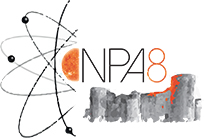Speaker
Livio Lamia
(LNS)
Description
Experimental nuclear astrophysics aims at measuring astrophysically relevant burning reaction cross sections at the corresponding Gamow energy. However, in spite of the improvements for measuring low-energy nuclear reaction cross sections, the Gamow energy region peak often remains far to be fully explored mainly in the case of charged-particles induced reactions. In such cases, both Coulomb barrier penetration and electron screening phenomena strongly affect the bare-nucleus cross section determination thus leaving extrapolation procedures as the only way for accessing the Gamow energy region. The Trojan Horse Method (THM) allows one to measure the bare-nucleus cross-section of an astrophysically relevant reaction a+x→c+C by properly selecting the quasi-free (QF) contribution of an appropriate reaction a+A→c+C+s, performed at energies well above the Coulomb barrier, where the nucleus A has a dominant x⊕s cluster configuration. Thanks to its momentum-energy prescription, THM allows to explore a wide energy window in the center of mass system a + x by only using a monoenergetic beam. Such advantage appears of great importance also in the case of nuclear reactions involving exotic nuclei or neutron induced reactions, thus justifying the recent THM application to well definite reactions involved in explosive or primordial nucleosynthesis.
[1] Spitaleri C. et al., Phys. of Atomic Nuclei, 74, 1725 (2011)
[2] Tribble, R. et al., Rep. Prog. Phys., 77, 106901 (2014)
Author
Livio Lamia
(LNS)

